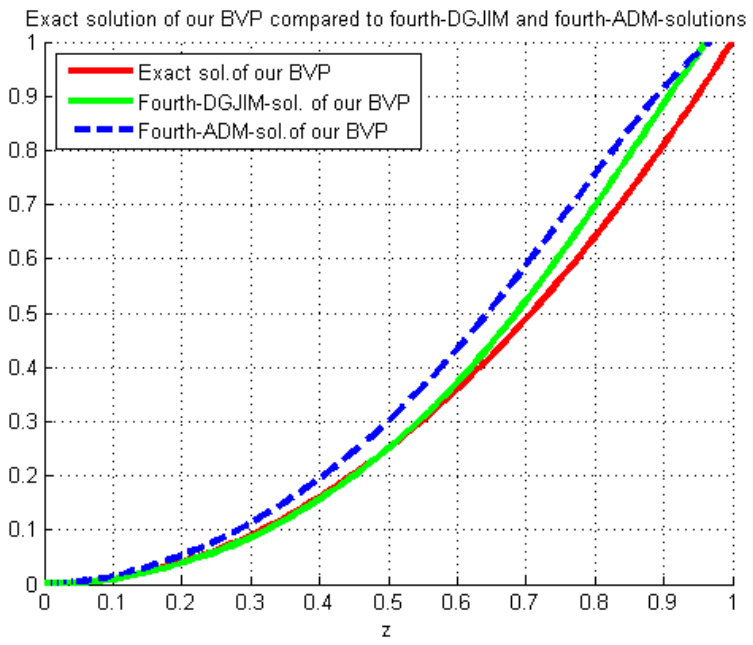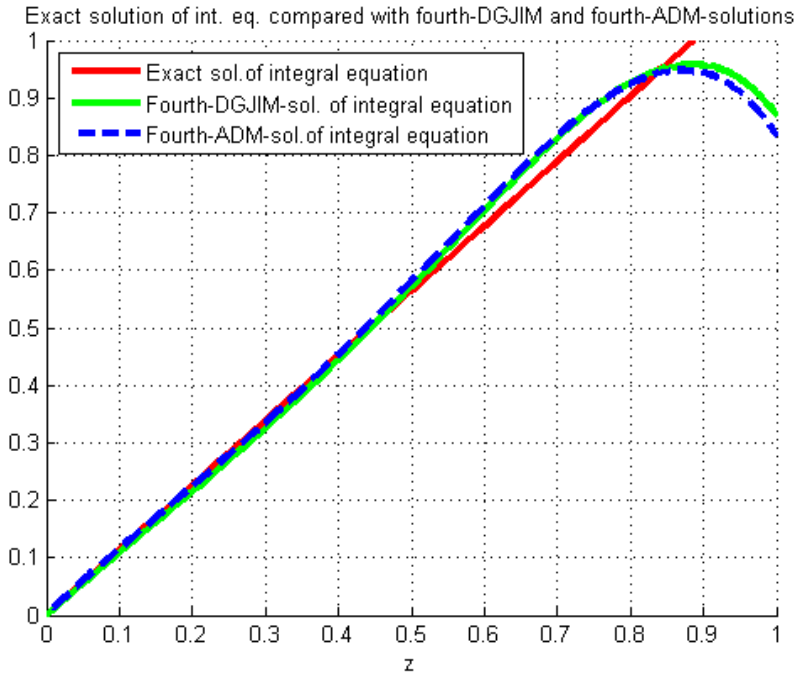Numerical Solutions Caused by DGJIM and ADM Methods for Multi-Term Fractional BVP Involving the Generalized ψ-RL-Operators
Abstract
1. Introduction
2. Preliminaries
3. Results on the Existence Criteria
- (H1)
- There exist , such thatfor any and .
- (H2)
- There exist two integrable functions and such that
- (H3)
- We have , where
4. Numerical Solutions via DGJIM and ADM Methods
4.1. The Numerical Technique DGJIM
4.2. The Numerical Technique ADM
5. Examples
- Numerical solutions via DGJIM method:
- Numerical solutions via ADM method:
6. Conclusions
Author Contributions
Funding
Institutional Review Board Statement
Informed Consent Statement
Data Availability Statement
Conflicts of Interest
References
- Kilbas, A.A.; Srivastava, H.M.; Trujillo, J.J. Theory and Applications of the Fractional Differential Equations; North-Holland Mathematics Studies: Amsterdam, The Netherlands, 2006; Volume 204. [Google Scholar]
- Podlubny, I. Fractional Differential Equations; Academic Press: New York, NY, USA, 1999. [Google Scholar]
- Samko, S.G.; Kilbas, A.A.; Marichev, O.I. Fractional Integrals and Derivatives: Theory and Applications; Gordon and Breach: Yverdon, Switzerland, 1993. [Google Scholar]
- Kaur, D.; Agarwal, P.; Rakshit, M.; Chand, M. Fractional calculus involving (p,q)-Mathieu type series. Appl. Math. Nonlinear Sci. 2020, 5, 15–34. [Google Scholar] [CrossRef]
- Gençoğlu, M.T.; Agarwal, P. Use of Quantum Differential Equations in Sonic Processes. Appl. Math. Nonlinear Sci. 2020, 1, 1–8. [Google Scholar] [CrossRef]
- Jajarmi, A.; Hajipour, M.; Baleanu, D. New aspects of the adaptive synchronization and hyperchaos suppression of a financial model. Chaos Solitons Fractals 2017, 99, 285–296. [Google Scholar] [CrossRef]
- Baleanu, D.; Jajarmi, A.; Hajipour, M. A new formulation of the fractional optimal control problems involving Mittag–Leffler nonsingular kernel. J. Optim. Theory Appl. 2017, 175, 718–737. [Google Scholar] [CrossRef]
- Dokuyucu, M.A.; Celik, E.; Bulut, H.; Baskonus, H.M. Cancer treatment model with the Caputo–Fabrizio fractional derivative. Eur. Phys. J. Plus 2018, 133, 92. [Google Scholar] [CrossRef]
- Singh, J.; Kumar, D.; Hammouch, Z.; Atangana, A. A fractional epidemiological model for computer viruses pertaining to a new fractional derivative. Appl. Math. Comput. 2018, 316, 504–515. [Google Scholar] [CrossRef]
- Hajipour, M.; Jajarmi, A.; Baleanu, D. An efficient nonstandard finite difference scheme for a class of fractional chaotic systems. J. Comput. Nonlinear Dyn. 2017, 13, 021013. [Google Scholar] [CrossRef]
- Abbas, M.I.; Ragusa, M.A. Solvability of Langevin equations with two Hadamard fractional derivatives via Mittag-Leffler functions. Appl. Anal. 2021. [Google Scholar] [CrossRef]
- Kosmatov, N.; Jiang, W. Resonant functional problems of fractional order. Chaos Solitons Fractals 2016, 91, 573–579. [Google Scholar] [CrossRef]
- Lu, C.; Fu, C.; Yang, H. Time-fractional generalized Boussinesq equation for Rossby solitary waves with dissipation effect in stratified fluid and conservation laws as well as exact solutions. Appl. Math. Comput. 2018, 327, 104–116. [Google Scholar] [CrossRef]
- Sudsutad, W.; Alzabut, J.; Nontasawatsri, S.; Thaiprayoon, C. Stability analysis for a generalized proportional fractional Langevin equation with variable coefficient and mixed integro-differential boundary conditions. J. Nonlinear Funct. Anal. 2020, 2020, 1–24. [Google Scholar]
- Abdo, M.S.; Shah, K.; Wahash, H.A.; Panchal, S.K. On a comprehensive model of the novel coronavirus (COVID-19) under Mittag-Leffler derivative. Chaos Solitons Fractal 2020, 135, 109867. [Google Scholar] [CrossRef]
- Baleanu, D.; Etemad, S.; Rezapour, S. A hybrid Caputo fractional modeling for thermostat with hybrid boundary value conditions. Bound. Value Probl. 2020, 2020, 64. [Google Scholar] [CrossRef]
- Khan, S.A.; Shah, K.; Zaman, G.; Jarad, F. Existence theory and numerical solutions to smoking model under Caputo–Fabrizio fractional derivative. Chaos Interdiscip. J. Nonlinear Sci. 2019, 29, 013128. [Google Scholar] [CrossRef] [PubMed]
- Mohammadi, H.; Kumar, S.; Rezapour, S.; Etemad, S. A theoretical study of the Caputo-Fabrizio fractional modeling for hearing loss due to Mumps virus with optimal control. Chaos Solitons Fractals 2021, 144, 110668. [Google Scholar] [CrossRef]
- Thabet, S.T.M.; Etemad, S.; Rezapour, S. On a new structure of the pantograph inclusion problem in the Caputo conformable setting. Bound. Value Probl. 2020, 2020, 171. [Google Scholar] [CrossRef]
- Abbas, M.I.; Ragusa, M.A. On the hybrid fractional differential equations with fractional proportional derivatives of a function with respect to a certain function. Symmetry 2021, 13, 264. [Google Scholar] [CrossRef]
- Adjabi, Y.; Samei, M.E.; Matar, M.M.; Alzabut, J. Lengevin differential equation in frame of ordinary and Hadamard fractional derivatives under three point boundary conditions. AIMS Math. 2021, 6, 2796–2843. [Google Scholar] [CrossRef]
- Afshari, H.; Kalantari, S.; Karapinar, E. Solution of fractional differential equations via coupled fixed point. Electron. J. Differ. Equ. 2015, 286, 2015. [Google Scholar]
- Afshari, H.; Karapinar, E. A discussion on the existence of positive solutions of the boundary value problems via ψ-Hilfer fractional derivative on b-metric spaces. Adv. Differ. Equ. 2020, 2020, 616. [Google Scholar] [CrossRef]
- Ahmad, B.; Ntouyas, S.K.; Alsaedi, A.; Agarwal, R.P. A study of nonlocal integro-multi-point boundary value problems of sequential fractional integro-differential inclusions. Dyn. Contin. Disc. Impuls. Syst. Ser. A Math. Anal. 2018, 25, 125–140. [Google Scholar]
- Baleanu, D.; Etemad, S.; Rezapour, S. On a fractional hybrid integro-differential equation with mixed hybrid integral boundary value conditions by using three operators. Alex. Eng. J. 2020. [Google Scholar] [CrossRef]
- Baleanu, D.; Rezapour, S.; Etemad, S.; Alsaedi, A. On a time-fractional integro-differential equation via three-point boundary value conditions. Math. Probl. Eng. 2015, 2015, 785738. [Google Scholar] [CrossRef]
- Boucenna, D.; Boulfoul, A.; Chidouh, A.; Ben Makhlouf, A.; Tellab, B. Some results for initial value problem of nonlinear fractional equation in Sobolev space. J. Appl. Math. Comput. 2021. [Google Scholar] [CrossRef]
- Boulfoul, A.; Tellab, B.; Abdellouahab, N.; Zennir, K. Existence and uniqueness results for initial value problem of nonlinear fractional integro-differential equation on an unbounded domain in a weighted Banach space. Math. Methods Appl. Sci. 2020. [Google Scholar] [CrossRef]
- Etemad, S.; Rezapour, S.; Samei, M.E. On a fractional Caputo-Hadamard inclusion problem with sum boundary value conditions by using approximate endpoint property. Math. Methods Appl. Sci. 2020. [Google Scholar] [CrossRef]
- Chen, Y.M.; Han, X.N.; Liu, L.C. Numerical solution for a class of linear system of fractional differential equations by the Haar wavelet method and the convergence analysis. Comput. Model. Eng. Sci. 2014, 97, 391–405. [Google Scholar]
- Jong, K.; Choi, H.; Jang, K.; Pak, S. A new approach for solving one-dimensional fractional boundary value problems via Haar wavelet collocation method. Appl. Num. Math. 2021, 160, 313–330. [Google Scholar] [CrossRef]
- Kumar, D.; Singh, J.; Baleanu, D. A new numerical algorithm for fractional Fitzhugh–Nagumo equation arising in transmission of nerve impulses. Nonlinear Dyn. 2018, 91, 307–317. [Google Scholar] [CrossRef]
- Veeresha, P.; Prakasha, D.G.; Baskonus, H.M. Solving smoking epidemic model of fractional order using a modified homotopy analysis transform method. Math. Sci. 2019, 13, 115–125. [Google Scholar] [CrossRef]
- Chen, Y.M.; Liu, L.Q.; Li, B.F.; Sun, Y.N. Numerical solution for the variable order linear cable equation with Bernstein polynomials. Appl. Math. Comput. 2014, 238, 329–341. [Google Scholar] [CrossRef]
- Sakar, M.G.; Akgül, A.; Baleanu, D. On solutions of fractional Riccati differential equations. Adv. Differ. Equ. 2017, 2017, 39. [Google Scholar] [CrossRef]
- Bolandtalat, A.; Babolian, E.; Jafari, H. Numerical solutions of multi-order fractional differential equations by Boubaker polynomials. Open Phys. 2016, 14, 226–230. [Google Scholar] [CrossRef]
- Hesameddini, E.; Rahimi, A.; Asadollahifard, E. On the convergence of a new reliable algorithm for solving multi-order fractional differential equations. Commun. Nonlinear Sci. Numer. Simul. 2016, 34, 154–164. [Google Scholar] [CrossRef]
- Firoozjaee, M.A.; Yousefi, S.A.; Jafari, H.; Baleanu, D. On a numerical approach to solve multi order fractional differential equations with boundary initial conditions. J. Comput. Nonlinear Dynam. 2015, 10, 061025. [Google Scholar] [CrossRef]
- Dabiri, A.; Butcher, E.A. Stable fractional Chebyshev differentiation matrix for the numerical solution of multi-order fractional differential equations. Nonlinear Dyn. 2017, 90, 185–201. [Google Scholar] [CrossRef]
- Padhi, S.; Graef, J.R.; Pati, S. Multiple positive solutions for a boundary value problem with nonlinear nonlocal Riemann–Stieltjes integral boundary conditions. Fract. Calc. Appl. Anal. 2018, 21, 716–745. [Google Scholar] [CrossRef]
- Thabet, S.T.M.; Etemad, S.; Rezapour, S. On a coupled Caputo conformable system of pantograph problems. Turk. J. Math. 2021, 45, 496–519. [Google Scholar] [CrossRef]
- Daftardar-Gejji, V.; Jafari, H. Adomian decomposition: A tool for solving a system of fractional differential equations. J. Math. Anal. Appl. 2005, 301, 508–518. [Google Scholar] [CrossRef]
- Daftardar-Gejji, V.; Jafari, H. An iterative method for solving nonlinear functional equations. J. Math. Anal. Appl. 2006, 316, 753–763. [Google Scholar] [CrossRef]
- Babolian, E.; Vahidi, A.R.; Shoja, A. An efficient method for nonlinear fractional differential equations: Combination of the Adomian decomposition method and spectral method. Indian J. Pure Appl. Math. 2014, 45, 1017–1028. [Google Scholar] [CrossRef]
- Khodabakhshi, N.; Vaezpour, S.M.; Baleanu, D. Numerical solutions of the initial value problem for fractional differential equations by modification of the Adomian decomposition method. Fract. Calc. Appl. Anal. 2014, 17, 382–400. [Google Scholar] [CrossRef]
- Loghmani, G.B.; Javanmardi, S. Numerical methods for sequential fractional differential equations for Caputo operator. Bull. Malays. Math. Sci. Soc. 2012, 35, 315–323. [Google Scholar]
- Jarad, F.; Abdeljawad, T. Generalized fractional derivatives and Laplace transform. Discret. Contin. Dyn. Syst. Ser. S 2020, 13, 709–722. [Google Scholar] [CrossRef]


Publisher’s Note: MDPI stays neutral with regard to jurisdictional claims in published maps and institutional affiliations. |
© 2021 by the authors. Licensee MDPI, Basel, Switzerland. This article is an open access article distributed under the terms and conditions of the Creative Commons Attribution (CC BY) license (http://creativecommons.org/licenses/by/4.0/).
Share and Cite
Rezapour, S.; Etemad, S.; Tellab, B.; Agarwal, P.; Garcia Guirao, J.L. Numerical Solutions Caused by DGJIM and ADM Methods for Multi-Term Fractional BVP Involving the Generalized ψ-RL-Operators. Symmetry 2021, 13, 532. https://doi.org/10.3390/sym13040532
Rezapour S, Etemad S, Tellab B, Agarwal P, Garcia Guirao JL. Numerical Solutions Caused by DGJIM and ADM Methods for Multi-Term Fractional BVP Involving the Generalized ψ-RL-Operators. Symmetry. 2021; 13(4):532. https://doi.org/10.3390/sym13040532
Chicago/Turabian StyleRezapour, Shahram, Sina Etemad, Brahim Tellab, Praveen Agarwal, and Juan Luis Garcia Guirao. 2021. "Numerical Solutions Caused by DGJIM and ADM Methods for Multi-Term Fractional BVP Involving the Generalized ψ-RL-Operators" Symmetry 13, no. 4: 532. https://doi.org/10.3390/sym13040532
APA StyleRezapour, S., Etemad, S., Tellab, B., Agarwal, P., & Garcia Guirao, J. L. (2021). Numerical Solutions Caused by DGJIM and ADM Methods for Multi-Term Fractional BVP Involving the Generalized ψ-RL-Operators. Symmetry, 13(4), 532. https://doi.org/10.3390/sym13040532








